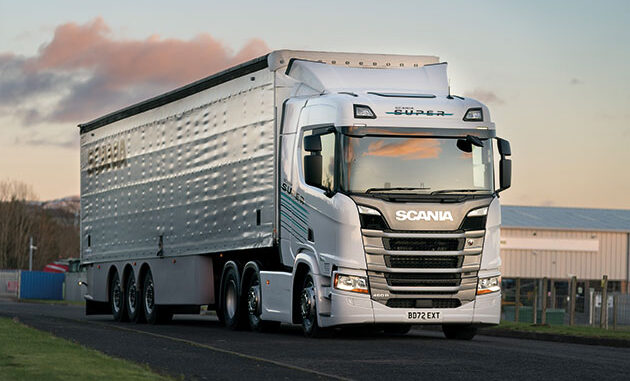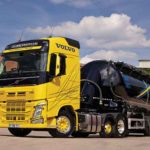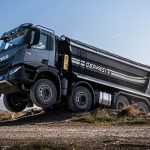
Scania unveiled a new engine platform designed to save the operator money, and it underpins this month’s road test, the 460R. Transport News resident road tester, Lochmaben Transport’s Stevie Walker, has been out for a drive.
IN NOVEMBER 2021 Scania launched a new engine. The Swedes’ research and development department had spent the best part of five years creating it from the ground up.
The Super 13 engine represents an investment of more than £1.76 billion. For that operators will get, according to Scania, better fuel efficiency, biofuel capability, better total operating economy figures and reduced CO2 emissions.
Scania confirmed that it has 50% thermal efficiency, uses dual overhead camshafts and twin selective catalytic reduction dosing of AdBlue. It’s purpose built for the implementation of renewable biofuels, explained Stefan Dorski, the senior vice president, at Scania Trucks.
Although the plan is to roll it out across all engines, the ‘13 litre’ is the first to get it with more power and torque, all for lower rpm; 420hp/2,300Nm, 460hp/2,500Nm, 500hp/2,650Nm, and 560hp/2,800Nm. Each is 10hp more and up to an extra 200-to-350Nm than the standard 13 litre engine.
For this test we had the 460, with a normal sleeper cab on a 6×2 axle configuration. It comes with Opticruise, Eco-Roll, economy performance mode, adaptive cruise control, driven attention support, and a single bunk with additional storage on the back wall.
WON OVER
Although not a massive fan of Scania’s products, over the past couple of decades I have operated a small number, the best being a 1995 N-registered Centurion, which was a very nice truck.
My opinion did change when I had my first drive in an S500 a couple of years back, where the new generation cab was a vast improvement on any Scania I have experienced, and I had to admit that at the time I was almost a convert.
The V8 has always had an unparalleled following, a sure way to fill seats for any operator with some drivers almost happy to drive them for a cheese sandwich and a pat on the back.
Its big flagship models give Scania a profile like no other manufacturer throughout Europe but even though the residuals are excellent with many operators having recently had the values appreciate, the big price tags and high running costs prevent them from being the obvious choice for the cost conscious operator.
The real workhorse is the 13 litre range and the R450 has been the star of the show for the past five years giving good financial returns and keeping a smile on plenty of drivers’ faces.
Time has not stood still though and neither has Scania. It appears that the manufacturer’s design and development team has not spent the past Covid years Tik-Toking or collapsed on the living room rug in front of a Swedish version of Joe Wicks.
Instead, they have been hard at it creating a lot of stuff to the point that they are obviously very chuffed with themselves as they have named it the new ‘Scania Super’.
As I arrive at Scania Dumfries to crack on with the test drive I get my first look at the new model. I’m a little disappointed because at first glance it would seem the only new bit is the ‘SUPER’ decal on the side and front.
The test truck for today being a normal cab height 460R (subtle change to the badge moving the prefix R behind the numbers) is nothing too flash and you would be hard pushed to tell it from an R450.
CAB RANKED
Nothing wrong with that though as the cab isn’t in need of a makeover yet, it’s still a very attractive cab with a strong quality look slightly less imposing than the big S line.
Formalities done, and it’s on to a truncated test route (Dumfries-Glasgow-Edinburgh-Abington-Dumfries).
The interior has a real quality about it, which is perhaps where Scania starts to gain a bit of ground on its competitors. The switch gear has a very similar look and robust feel that is recognisable throughout previous generations of cabs.
Two tone dark and light grey looks clean and tidy with the usual plethora of buttons which I haven’t got time to get my head round.
The stylish leather stitched steering wheel emblazoned with yet more finger and thumb controls allows a good view of the dash and a good range of movement to welcome all shapes of drivers.
However, the seat styling isn’t really my cup of tea, it looks like an incomplete DNA structure (or old bus seats from the 1980s).
The leather option is indeed very nice if the budget allows. Although it’s the smaller cab, there is still plenty of room to stand up and move around, ample storage for a week away and generally a very nice environment to work and relax in with all the bells and whistles that you would expect as a standard.
Getting the show on the road, I get my first feel for the Opticruise gearbox. It’s nothing like the ‘3 pedal’ semi-automated version that I occasionally used to drive, which was designed for start and stop and low speed manoeuvring, particularly for the construction sector, as well as trailer coupling.
Immediately you get a sense of control, and the changes are slick and quiet, and it amazes me how you can hop into an unfamiliar vehicle and nothing feels alien or awkward.
ON THE ROAD
As we head out towards the M74 I begin to realise what the Super is all about. Having no previous knowledge of the truck I expected it to be new gizmos and flash new styling to turn heads but that’s not the case. All the new stuff is under the surface and the Scania boffins have been busy.
Accepting the fact that the combustion engine is here for a good number of years, Scania have set about making it more efficient, lighter and cleaner, the results are a claimed 8% fuel saving, near 300kg weight saving overall, 30% longer service life and an emissions system which they believe to be Euro 7 ready.
The engine also has the ability to run on hydrogenated vegetable oil (HVO), so this could be significant as there is sure to be an abundance of the stuff now that everyone is using Air Fryers!
As we pull onto the M74 at Beattock and start to build up a bit of momentum I can hardly sense the gear changes, slick, fast and quiet all thanks to the latest G25CM Opticruise gearbox program.
The new gearbox plays a role in the overall weight reduction shaving 75kg off its predecessor and has 14 forward gears including a crawler and an overdrive.
With cruise control set I can relax a bit in the very quiet environment, there is hardly a sound from the new engine even though it is working hard pulling up Beattock summit. For a sub-500hp engine the Scania performs remarkably well and with its low rev philosophy it will be efficient on the climb too.
The truck sits well on the motorway requiring very little input from me, which is just the way it should be. Visibility is good and the seat is very comfortable, even better now I can’t see the pattern.
On the descent towards Cairn Lodge the engine compression brake kicks in to slow the over run. For most applications the compression brake is plenty strong enough, but it can be accompanied by Scania’s retarder to give 600kW of supplementary stopping power if terrain or heavy weights so require.
As the terrain levels out a bit I notice the Scania occasionally slipping into overdrive, it never remains there for long as we are running with decent weight behind us, not that you would think so as the 460 pulls like a train (probably not the best analogy these days as most of the trains are stationary).
The overdrive will come into its own on lighter operations and certainly on empty running but every drop in revs will help with the bottom line and overall engine lifespan.
Most of the test route remains fairly uneventful, the Scania eats up the miles.
We hit a bit of standing traffic approaching the Edinburgh Bypass, but the smooth gearbox allows for the start stop to be invoked without any fuss, I can’t understand why anyone would prefer a manual gearbox these days and to be fair there are fewer and fewer die-hards around.
The traffic doesn’t hold us up too much and we are soon onto the A702 for the wiggly section of the route down to Abington, a chance to show off my lack of driving skill!
However, this Scania 460R makes it easy for me, another sure-footed truck which soaks up the corners like it’s on rails. No air suspension on this cab means there is next to no cab roll, but the ride is still very comfortable.
With mirrors still the only option on the Super I still have to be careful when meeting other heavy traffic on some of the narrow sections, I find this to be one of the real benefits of cameras and monitors. Scania will be offering their version soon, I believe, also as a retrofit.
Back at Scania Dumfries I get a chance to look over the truck from the outside, the test drive is one thing, there isn’t much to fault from a driver’s perspective, the 460R is a ‘middle of the road’ model aimed at fleet operations looking for an economical truck that still pleases drivers.
It fits the bill exactly on that account, but drivers possibly aren’t really going to appreciate the level of effort Scania has put in to developing the Super, it truly is a remarkable bit of engineering, designed from the ground up with so much new technology.
There is a lot to like here; from the dual dosing SCR system, which fires a bit of AdBlue both around the turbo area and the usual silencer position, to the new engine, new gearbox and axle.
Plus, the completely redesigned D shaped fuel tanks which, combined with a tricky fuel optimisation system, increases the volume of usable fuel in the tank, gives easier access to service points and hopefully decreases down time.
A new modular chassis design offers better flexibility for the body builder allowing greater freedom.
SUMMING UP
Scania seems to have come out of the pandemic years fighting fit; leaner, greener, and more powerful, and in doing so they have come a long way to future proofing themselves as we head ever closer to the demise of the internal combustion engine.
The many technological improvements to what was already a great range of trucks aren’t immediately obvious to the driver although the Super Scania is a much smoother and quieter workspace and has bags of grunt. The improvements are really geared towards the operator, offering up improved fuel economy, flexibility, service life and payload.
The environment is another beneficiary of Scania’s hard work and the development team themselves can perhaps relax a bit with the knowledge that with Euro 7 looming they already have their foot in the door.
The boffins really do have something to feel proud of as this truck truly is Super, as the name suggests, and I have no doubt that they will continue to push the boundaries during the time we have left with the diesel engine.
I am very impressed with this truck and feel encouraged to look at the range when replacing vehicles, but there is much to consider when making large investment such as these.
The stats mentioned here are improvements against the previous model, so it will be interesting to see how it stacks up against its competitors and I would be foolish to imagine that all these improvements don’t come at a cost.
Specification: Scania 460R
Cab: CR Normal Sleeper.
Engine: DC13 12.74 litre six-cylinder in line, with Scania’s XPI injection system with unit injectors and four valves per cylinder. It is fitted with a fixed geometry turbocharger, charge air cooler and Scania’s twin SCR system.
Maximum power: 453hp at 1,800rpm.
Maximum torque: 2,500Nm from 900 to 1,290rpm.
Gearbox: Automated Opticruise Direct Top G25 12-speed.
Rear axle ratio: 2.59:1.
Wheelbase: 4,050mm.
Suspension: Front suspension type, front, parabolic; rear, air with lifting second axle.
Brakes: Disc brakes, with full ABS and EBS.
Parking brake: Electronically controlled spring brake actuators on first and drive axles.
Secondary brake: Exhaust brake, max 200kW at 2,400rpm.
Steering: Recirculating hydraulic power assisted.
Wheels: Steel on all axles.
Tyres: Fitted with 315/70R22.5 Goodyear KMAX.
Tank capacities: Diesel; two tanks, 465 litres; AdBlue; one tank, 76 litres.
Plated weights: Front axle, 8,000kg; mid-axle, 6,000kg; drive axle, 10,000kg.
Kerbweight: 8,482kg (no driver, full tanks).
Trailer: Triaxle curtainsided, 4.0m.
Weather: Dry, bright, 19mph northerly wind, 2 degrees centigrade.
Date of test: 16 January 2023.
Route: Starts at Lockerbie Lorry Park (as was) heading north from M74 J16 to Glasgow J4 and joins the M73 towards Denny then M80 north past Stirling. At Dunblane, onto the A9 past Auchterarder to Perth and join M90 south towards Kinross and onto Forth Road Bridge. Turn onto the eastbound M8 then around A720 Edinburgh bypass to A702 heading southbound passing Penicuik and Biggar. At Abington Motorway Services re-join M74 J13 southbound to M74 J16 and finish at Lockerbie Truckstop. Mileage: 191.5.




